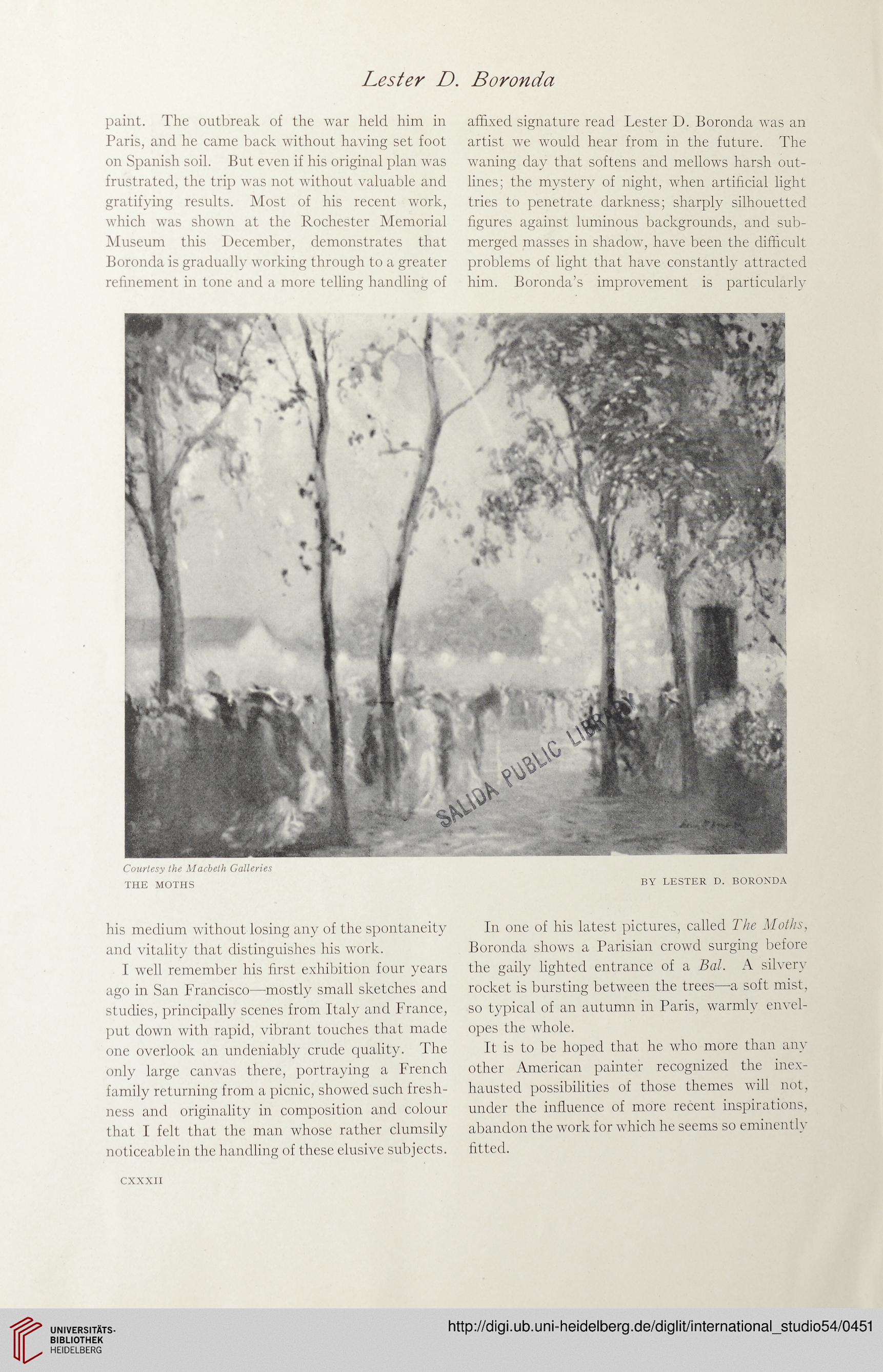Lester D. Boronda
paint. The outbreak of the war held him in
Paris, and he came back without having set foot
on Spanish soil. But even if his original plan was
frustrated, the trip was not without valuable and
gratifying results. Most of his recent work,
which was shown at the Rochester Memorial
Museum this December, demonstrates that
Boronda is gradually working through to a greater
refinement in tone and a more telling handling of
affixed signature read Lester D. Boronda was an
artist we would hear from in the future. The
waning day that softens and mellows harsh out-
lines; the mystery of night, when artificial light
tries to penetrate darkness; sharply silhouetted
figures against luminous backgrounds, and sub-
merged masses in shadow, have been the difficult
problems of light that have constantly attracted
him. Boronda’s improvement is particularly
Courtesy the Macbeth Galleries
THE MOTHS BY LESTER D. BORONDA
his medium without losing any of the spontaneity
and vitality that distinguishes his work.
I well remember his first exhibition four years
ago in San Francisco—mostly small sketches and
studies, principally scenes from Italy and France,
put down with rapid, vibrant touches that made
one overlook an undeniably crude quality. The
only large canvas there, portraying a French
family returning from a picnic, showed such fresh-
ness and originality in composition and colour
that I felt that the man whose rather clumsily
noticeable in the handling of these elusive subjects.
In one of his latest pictures, called The Moths,
Boronda shows a Parisian crowd surging before
the gaily lighted entrance of a Bal. A silvery
rocket is bursting between the trees—-a soft mist,
so typical of an autumn in Paris, warmly envel-
opes the whole.
It is to be hoped that he who more than any
other American painter recognized the inex-
hausted possibilities of those themes will not,
under the influence of more recent inspirations,
abandon the work for which he seems so eminently
fitted.
CXXXII
paint. The outbreak of the war held him in
Paris, and he came back without having set foot
on Spanish soil. But even if his original plan was
frustrated, the trip was not without valuable and
gratifying results. Most of his recent work,
which was shown at the Rochester Memorial
Museum this December, demonstrates that
Boronda is gradually working through to a greater
refinement in tone and a more telling handling of
affixed signature read Lester D. Boronda was an
artist we would hear from in the future. The
waning day that softens and mellows harsh out-
lines; the mystery of night, when artificial light
tries to penetrate darkness; sharply silhouetted
figures against luminous backgrounds, and sub-
merged masses in shadow, have been the difficult
problems of light that have constantly attracted
him. Boronda’s improvement is particularly
Courtesy the Macbeth Galleries
THE MOTHS BY LESTER D. BORONDA
his medium without losing any of the spontaneity
and vitality that distinguishes his work.
I well remember his first exhibition four years
ago in San Francisco—mostly small sketches and
studies, principally scenes from Italy and France,
put down with rapid, vibrant touches that made
one overlook an undeniably crude quality. The
only large canvas there, portraying a French
family returning from a picnic, showed such fresh-
ness and originality in composition and colour
that I felt that the man whose rather clumsily
noticeable in the handling of these elusive subjects.
In one of his latest pictures, called The Moths,
Boronda shows a Parisian crowd surging before
the gaily lighted entrance of a Bal. A silvery
rocket is bursting between the trees—-a soft mist,
so typical of an autumn in Paris, warmly envel-
opes the whole.
It is to be hoped that he who more than any
other American painter recognized the inex-
hausted possibilities of those themes will not,
under the influence of more recent inspirations,
abandon the work for which he seems so eminently
fitted.
CXXXII




